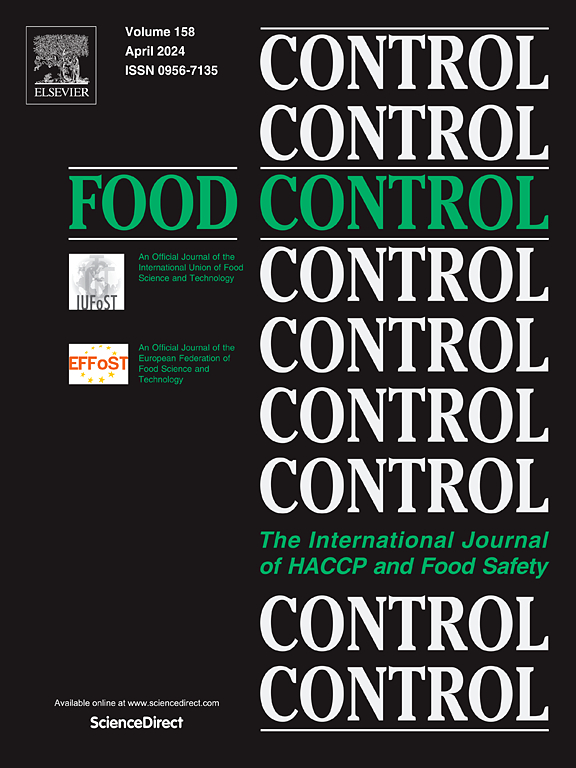Is there a better way to preserve Cheese? Evaluating protective cultures to conventional preservatives
IF 5.6
1区 农林科学
Q1 FOOD SCIENCE & TECHNOLOGY
引用次数: 0
Abstract
Preservatives are utilized to inhibit the growth of spoilage and pathogenic microorganisms in food, thus improving shelf life and reducing food waste. Despite the effectiveness of current preservatives, consumer health concerns have spurred interest in natural alternatives. This study explored the effects of traditional preservatives, nisin (N), potassium sorbate (Ps) and protective cultures, Lactiplantibacillus plantarum (Lp), Lacticaseibacillus rhamnosus (Lr) both individually and in various combinations on the physicochemical properties and microbial inhibition of Turkish white cheese over 28 days of storage. To this end, thirteen cheese samples were produced and analyzed: one without preservatives (C), four with a single preservative (N, Ps, Lp, Lr), and eight with combinations (NLr, NLp, NPs, PsLr, PsLp, LpLr, LpLrN, LpLrPs). The use of preservatives did not alter compositional characteristics, but acidity increased rapidly in samples with protective cultures. The combination of N and Ps with protective cultures produced a stronger antimicrobial effect compared to N and Ps alone, while Lp and Lr combinations showed promising results. Inhibition of coliforms and Escherichia coli was achieved using either N or protective cultures alone. The combined use of Lp and Lr was more effective against all analyzed microorganisms than either alone. Sensory analysis indicated no significant difference in overall acceptability between preservative-treated and control samples. These findings highlight the potential of protective cultures as a natural alternative to traditional preservatives and suggest their use in combination can enhance food safety by providing more effective inhibition.
有更好的保存奶酪的方法吗?评价保护性培养物对常规防腐剂的影响
防腐剂被用来抑制食物中腐败和致病微生物的生长,从而延长保质期,减少食物浪费。尽管目前的防腐剂有效,但消费者对健康的担忧激发了对天然替代品的兴趣。本研究探讨了传统防腐剂、乳杆菌素(N)、山梨酸钾(Ps)和保护性培养物、植物乳杆菌(Lp)、鼠李糖乳杆菌(Lr)单独和不同组合对土耳其白奶酪28 d贮藏过程中理化性质和微生物抑制作用的影响。为此,制作并分析了13份奶酪样品:一份不含防腐剂(C),四份含单一防腐剂(N, Ps, Lp, Lr),八份含组合防腐剂(NLr, NLp, NPs, PsLr, PsLp, LpLr, LpLrN, lplrp)。防腐剂的使用并没有改变样品的组成特征,但酸度在保护性培养的样品中迅速增加。N和Ps与保护性培养物的组合比单独使用N和Ps具有更强的抗菌效果,而Lp和Lr的组合也有很好的效果。对大肠菌群和大肠杆菌的抑制作用可单独使用N或保护性培养物。Lp和Lr联合使用对所有分析的微生物都比单独使用有效。感官分析表明,防腐剂处理样品和对照样品的总体可接受性没有显著差异。这些发现突出了保护性培养物作为传统防腐剂的天然替代品的潜力,并表明它们的组合使用可以提供更有效的抑制作用,从而提高食品安全。
本文章由计算机程序翻译,如有差异,请以英文原文为准。
求助全文
约1分钟内获得全文
求助全文
来源期刊

Food Control
工程技术-食品科技
CiteScore
12.20
自引率
6.70%
发文量
758
审稿时长
33 days
期刊介绍:
Food Control is an international journal that provides essential information for those involved in food safety and process control.
Food Control covers the below areas that relate to food process control or to food safety of human foods:
• Microbial food safety and antimicrobial systems
• Mycotoxins
• Hazard analysis, HACCP and food safety objectives
• Risk assessment, including microbial and chemical hazards
• Quality assurance
• Good manufacturing practices
• Food process systems design and control
• Food Packaging technology and materials in contact with foods
• Rapid methods of analysis and detection, including sensor technology
• Codes of practice, legislation and international harmonization
• Consumer issues
• Education, training and research needs.
The scope of Food Control is comprehensive and includes original research papers, authoritative reviews, short communications, comment articles that report on new developments in food control, and position papers.
 求助内容:
求助内容: 应助结果提醒方式:
应助结果提醒方式:


